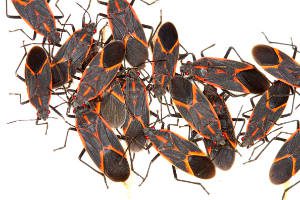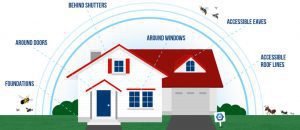Autumn in New England is officially here! What does that mean for pests?
By Zachary Ciras on September 24, 2021.
Autumn is welcome, pests are not!
New Englanders love the changing of the seasons, especially going into the fall. The leaves are beginning to change colors, the night air is getting crisp and refreshing, and fall sports are in focus. With school children finding their school year routines, what other changes can we expect?
Autumn brings stinging arthropods into the forefront as a pest concern. Occasional invaders are becoming more prevalent, and all sorts of critters are looking for a warmer place to spend the impending winter season. Colonial Pest can help!
Stinging Pests in the Fall
Yellow Jacket queens have been around since the springtime, building a small nest with individual cells for each egg to grow. The nest grows through the summer, but late summer and autumn is when their hard work is on display. (See: Fall Yellowjackets Are The Worst!) Yellow Jacket nests can contain between 500-5,000 individuals, with some species nesting in wall voids and ground voids, while others build impressive, multi-tiered nests in trees, bushes, and affixed to structures. (See: How Do You Know If Yellowjackets Are Nesting In Your House?)
Bald Faced (White Faced) Hornets, a cousin of Yellowjackets, also are in season in the fall. They build large paper domed nests in trees and on structures. These wasps are territorial and aggressive. As the weather cools, wasps alter their behavior away from rapid nest expansion to foraging for food and preparing for the winter. Some queens will overwinter and survive to start a new nest next year. Colonies begin producing more males and larger hexagon cells in the fall as well. To learn more about which wasps to avoid, see Can That Thing Sting Me?
Occasional Invaders

Boxelder Bugs (Boisea trivittata)
The cooler fall temperatures invite occasional invader pests into your home. Insects from outside of your home will often seek out the safety and warmth of your home when the weather turns cold. These occasional invader pests recognize the changing seasons, and may start to move inside at this time of year to beat the cold before the first frosts. Some common occasional invaders are ladybugs, stink bugs, boxelder bugs, conifer seed bugs, ground beetles, and spiders. Carpenter Ants will often venture inside in the fall as well, overwintering and reemerging as early as February. See: Keep Fall Pest Invaders Out! and Outdoor Insects Are Getting Ready to Move Inside!
Rodents Want to Escape the Cold, Too!
Rodent activity tends to increase in the fall as well. Mice especially are accustomed to the cycles of moving in side in the fall to stay the winter in comfort. Mice take advantage of small gaps around your home as small as 1/4″. Gaps at the corners of the siding, behind the front steps, and through the garage are common entry points for mice to enter. Colonial Pest can help to not only control an existing population of mice, but also help prevent mice from entering your home by closing these small openings. (See: Take Steps Now to Keep Mice Out This Fall and Deer Mice! House Mice! Refuse To Share Your Home)
Prevent Pests in Every Season
Colonial Pest Control’s Preventative Maintenance Program works year round to prevent and control pest issues at your home. We create a barrier on the exterior of your home to prevent pest entry and nesting, and warranty for mouse control among many other pests! For more information, please call us at 800-525-8084 and schedule a service or consultation. We would love to partner with you to keep your home pest free this season and all year round.
